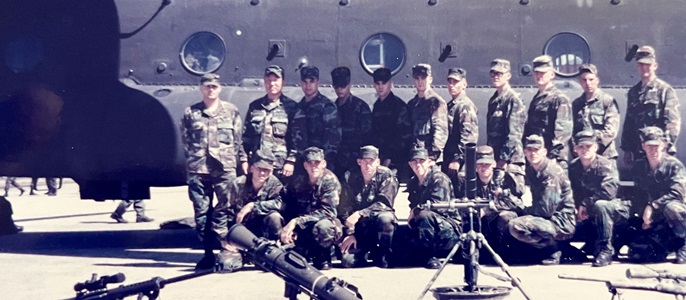Hear from the team making this mission possible. The mission is a team effort, bringing together employees from across the company.
Switchboards in the Sky
Playing a key role in the nation's MILSATCOM mission

By Caroline Mroz
Director Diane Legler ends her welcome speech to interns and college hires on her military satellite communications team with a bit of humor: “Now, go into the lab and look at some equipment that's definitely older than you.”
Diane’s team sustains the Milstar military satellite communications (MILSATCOM) system, which celebrated 30 years on orbit this past February, three times its intended design life. On the ground, the team tests software on an exact replica of the satellite, an engineering model payload that was built alongside the hardware now in orbit.
Milstar partners with the Advanced Extremely High Frequency (AEHF) system — which Diane’s team also supports — to deliver critical military communications to U.S. forces worldwide. Both systems feature Northrop Grumman-built MILSATCOM payloads.
“We build with primary and redundant hardware so that if you lose the primary hardware, you can switch to the redundant side. I like to tell people that much of Milstar is still operating on the primary side,” said Diane, who helped develop both systems early in her career. “These products have stood the test of time and are still used daily by military users.”
Communications Revolution
Northrop Grumman has played a major role in satellite communications from the start. Heritage company Space Technology Laboratories supported the U.S. Army Signal Corps’ development of the world’s first communications satellite — Project SCORE — which launched in 1958 and broadcast a Christmas greeting from President Dwight D. Eisenhower across the globe.
While successive MILSATCOM programs brought new capability and coverage, the development of Milstar in the 1980s and 1990s represented a generational leap forward — and a new type of satellite communication, called protected communications, able to evade and counter adversaries attempting to degrade, intercept or jam U.S military messages.
“Northrop Grumman and our heritage companies laid the foundation for many capabilities that are in space and, today, are used all the time, every day,” said Diane.
Milstar’s payloads also introduced the world’s first onboard digital processing, a revolutionary capability that Northrop Grumman has delivered on every MILSATCOM payload since. These processors can be reconfigured and updated from the ground, enabling constant improvement even once the satellite is in orbit.
“It’s like updating the software on your phone except, in the case of these satellites, the hardware is in space, not in the palm of your hand,” said Software Engineer Ryan Li, who works in MILSATCOM sustainment. “Every year, we release a new version of the software which improves performance or provides additional features and capabilities to help the end user.”
An Eye on the Future
Systems Engineering Manager Jasmine Naseri likens MILSATCOM systems to a family tree. After Milstar came AEHF, a six-satellite constellation that expanded communications capabilities while maintaining protection. AEHF is also backward compatible to Milstar, ensuring seamless global communication.
“AEHF set the stage for many programs to come,” Jasmine said. “And for me, having started my career on AEHF, it was exciting to actually see the satellites in the high bay and know where all your hard work is going.”
Since the final AEHF launch in March 2020, Northrop Grumman has continued expanding MILSATCOM’s reach. The most recent mission, the Enhanced Polar System Recapitalization (EPS-R), launched earlier this year, extending AEHF’s coverage in the Arctic. The EPS-R payload represented a historic first, as it was the first operational U.S. military payload to be hosted on an internationally operated, commercial satellite — Northrop Grumman’s GEOStar-3 satellite bus.
“We have a deep knowledge of all these heritage programs, and I feel that legacy every day,” said Guidance, Navigation and Control Engineer Callie Swafford, who started her career on EPS-R.
With decades of expertise, Northrop Grumman continues to play a key role in the nation’s MILSATCOM mission. The company is currently developing prototypes for Evolved Strategic SATCOM and Protected Tactical SATCOM, two systems which will mark the next generation of protected MILSATCOM. Legacy programs provide invaluable opportunities for early-career employees to learn from past successes while writing this next chapter.
“A lightbulb moment for me was realizing that these legacy programs are the foundation for many newer satellite projects,” Ryan said. “Learning the intricacies of AEHF will help me understand and develop future projects in the MILSATCOM space.”
Life at Northrop Grumman
Your work at Northrop Grumman makes a difference. Whether you want to design next-generation aircraft, harness digital technologies or build spacecraft that will return humanity to the moon, you’ll contribute to technology that’s transforming the world. Check out our career opportunities to see how you can help define possible.


